Planning and Running a Large Club Event
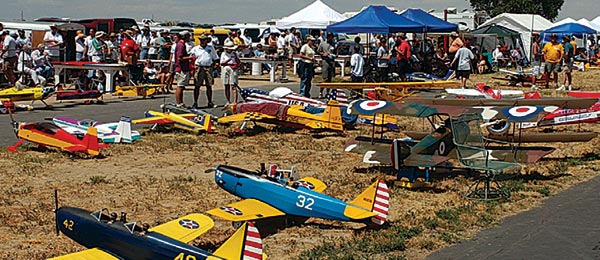
Written by Neil Miles For members As seen in the July 2004 issue of Model Aviation.
What are some goals your club would like to accomplish with its main event this year? Perhaps raising operating funds, attracting new members, raising your club’s profile in the community, improving the club’s reputation among other clubs in your area, or generally making your event the social RC hit of the year in your region. Your group can accomplish many or all of these goals with its major event of the year; all it takes is a strong team, hard work from most of your club’s members, and solid organization. Did I mention hard work? The Rocky Mountain Big Bird Festival—sponsored by the Love-Air R/C club in northern Colorado, of which I am a member—is a Giant Scale fly-in that celebrated its 10th anniversary in August 2003. With a history of demonstration pilots including Chip Hyde, Quique Somenzini, Sean McMurtry, Bill Hempel, Garrett Morrison, and Doug Gearman; more than 100 pilot participants; and an excess of 2,500 spectators, this gathering has grown to be one of the premier RC events in the region.

Garrett Morrison was the featured pilot at the 2003 Rocky Mountain Big Bird Festival. The crowd loved his performance!
The fly-in brings thousands of dollars per year into the Love-Air R/C’s operating fund, attracts 10-20 new members each year, exposes thousands of spectators to the best of RC flying, and is now a must-attend event for an ever-increasing number of RC fliers from roughly 10 Western states. In this article I will outline some of the keys to this event’s success to help your club accomplish its goals with an event. Many decisions made will depend on your club’s objectives for its key event. Decide what the group wants to accomplish, and include/exclude items from the plan to help get you along that path. Some of the following points may not apply to your event; however, they may allow your club to be more creative in planning its next activity. And later we might read about your events in MA! Our club and leadership team has learned a great deal in the past decade about how to successfully manage an event that has grown from a small club activity to a regional place to be. Love-Air R/C is not a superclub; it is typical, with approximately 170 members. However, we are blessed to have a great flying facility, and we have a committed core of capable leaders managing the Big Bird Festival. Key decisions were made in developing the gathering. They were to: • Pick a unique event focus and type. • Choose a consistent time of year that does not conflict with other regional activities. • Include the public as spectators and plan for their enjoyment and parking. • Raise club funds through the public raffle of a custom-built RTF aircraft. • Market the event in MA and in local newspapers, and produce a color brochure. • Bring in some of the top names in RC Aerobatics as demonstration/air-show pilots. As you plan your club’s event, look around to see what would be interesting, fun, and could attract pilots from an event type and time-frame standpoint. Consider your flying facility and what type of events would work best (e.g., jets and close-in trees may not be the optimal fit). Then the serious planning can begin.
Planning
Planning is the key to making any major event work well. We start team meetings in January or February to decide on the show pilots and get a start on the marketing for the August event. We try to request our event sanction early from AMA to ensure that our ads will run and that we get on the calendar. We submit event announcements to AMA’s Competition Department for MA’s “Contest Calendar” in March, and we submit our 1⁄4-page ad to MA in March or April, depending on the ad deadlines. Deadlines for advertising depend on the time of year of your event. Contact your target publication and work your ads back from their submission deadlines. A critical factor is appointing committee leads for each important facet of the team structure. The event director and contest director lead the team, and they take care of many duties by themselves. Additional committee directors cover field preparation, running our public raffle, public relations/marketing, sponsors/prize donations, air-show-pilot coordination, the air-boss team, concessions/vendor relations, public-address (PA)/music-system direction, the transmitter impound, and, most important, the parking team. We hold monthly meetings before our regular club meetings to keep the team aligned, moving forward, and handling any issues that arise. We also regularly discuss the festival in our club meetings to keep the membership informed, answer questions, recruit additional volunteers, and collect any new ideas the members have. Your event’s theme and type should reflect your club’s interests to encourage as many critical volunteers as possible. Inevitably, at every well-managed RC event, a sizable portion of the club’s members are involved in running it. We have found that nothing works better than a heartfelt personal invitation to get a volunteer signed up. Our committee leads reach out to help club members volunteer for their teams.Safety Considerations
Safety should be the number-one consideration when running any event. Pilot and spectator safety are combined in our hobby because of the observers’ proximity to the aircraft. A competent event staff must perform careful pilot/airplane inspections before any aircraft leaves the ground—especially for large Scale or Aerobatics models. Thorough inspections include checking such items as hinges, linkages, and propeller condition. Proper safety fencing, spectator/crowd control, and strictly monitoring the participants’ flying ensure spectator safety. We use a team of air bosses with radio systems, fluorescent vests, and coordination with the announcers to keep the flightline safe and enjoyable for all. The air bosses watch for erratic flying or violations of the specified no-fly zones; if they see an infraction, they ask the offending pilot to land immediately.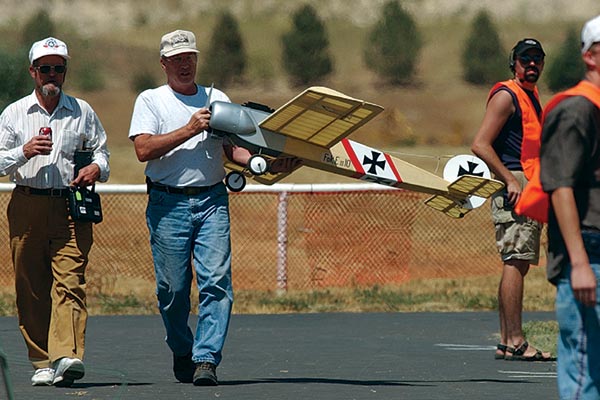
Air bosses with radio headsets control runway access and flight operations at an event. You can see the flight-station safety fencing in the background.
Our field has three taxi entrances to the runway. The air bosses control the flow of on-deck pilots at two of the entrances and the safe landing, shutdown, and collection of models at the third. The air bosses call changes in the wind direction and tell the pilots when they must flip the flying and landing pattern. They are also responsible for informing all pilots if a landing or dead-stick approach is underway or called. A polite, firm voice and some experience are air-boss requirements, so older club members are typically more successful than our junior members. To keep each participant better aware of the situation surrounding his or her aircraft, we require all pilots to have callers with them at the designated pilot stations. Some initially resist this rule since we hold more of a fun-fly event, but with as many as six models in the air, with their different types and speeds, fliers soon realize that flying with a buddy is much safer. Besides, only the caller can really watch the other airplanes, pay attention to the air bosses, relay the good-natured ribbing that takes place, correct the announcer on the aircraft’s description, and retrieve the model at the end of its flight. A well-functioning transmitter impound is mandatory for a well-managed event. Our impound team is a good-natured bunch, and we supply a weatherproof trailer with temporary shelving inside to make the impound process enjoyable and safe for all pilots. We use a frequency analyzer to check for transmitters left on and for radio problems. If turbine-powered jets are present, additional fire extinguishers must be present and a fire crew must be standing ready.
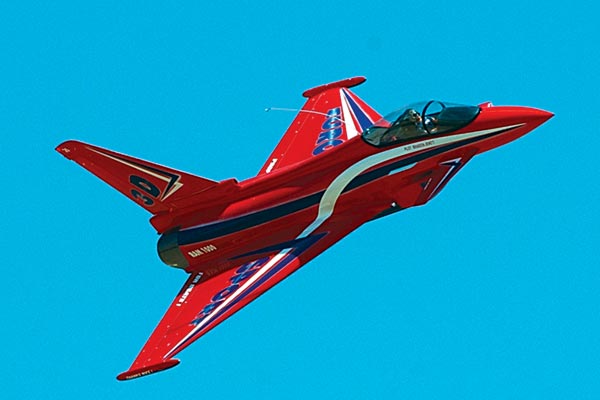
This turbine-powered Eurofighter wowed the crowd with its sound and speed. Safety is paramount with this type of model.
Remember to consider spectator/pilot physical separation for safety’s sake, and check in with local fire and rescue services to ensure that they know the best routes to your event and what they can expect from a crowd and access standpoint. GPS (Global Positioning System) coordinates often help emergency crews understand exactly where you are in relation to your road access points. We maintain crowd control by having all club staff, pilots, and pit crews wear badges while in the flying/pit areas. If someone crosses the spectator fence line and is not wearing a badge, we ask that person to step back to the spectator area for his or her own safety.
Generating Club Funds
The main source of revenue from our event is a public raffle for an RTF Giant Scale model. It is one of a series of modified Sig Kadets that one of our members originally created. It is constructed by one of our members who custom-builds models for others.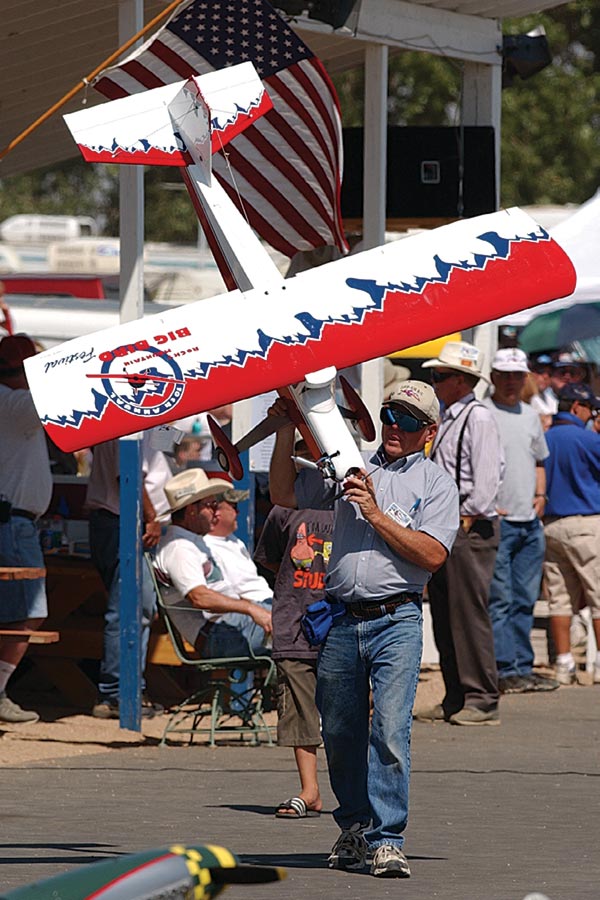
A public raffle prize such as this 82-inch-span “Quinn” Kadet RTF can increase crowd participation and interest.
The Kadet spans 82 inches and comes with the radio fully installed. It is immaculately covered and truly ready to fly (except for charging the batteries and adding fuel). This airplane has an excellent reputation with the region’s pilots and looks great. Since we fly identical models on spectator buddy-box machines during our event, visitors can see that it flies extremely well. The quality of our raffle airplane helps us sell a good quantity of raffle tickets each year. Although most club members can sell raffle tickets, certain unique individuals truly excel at it. Our resident supersalesman knows nearly every business owner in our area and could sell iceboxes to Eskimos. Engaging your supersalesmen/women and finding the right prize(s) will enable your raffle to generate enough funds to cover costs and help build excitement. Although the entire club sells raffle tickets for months before the event, we sell many tickets during the festival, and we hold the drawing at the close of the event. Every year crowd members stay in the stands hoping they will win the model.
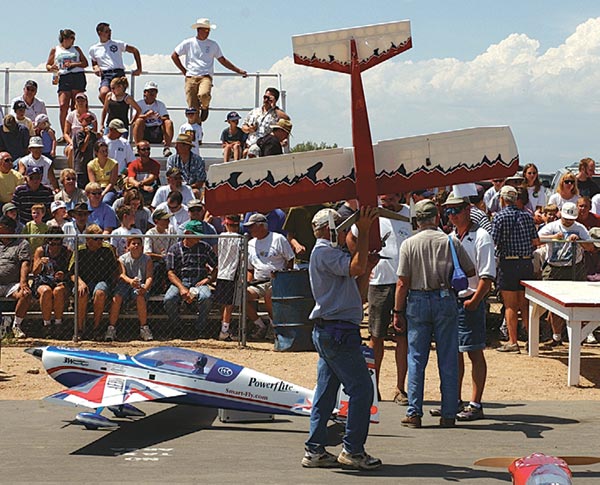
The raffle-prize aircraft is shown to the crowd throughout the day to generate incremental ticket sales.
Remember to follow all state rules for holding a public raffle. Register it with the correct authorities, and handle the ticket numbers and stubs according to their regulations. We have a team who does the necessary research and runs our raffle beautifully each year. Another way we help to cover event costs is to ask for a $2 donation per vehicle for parking. We rent an additional field from a local farmer, where we park more than 800 spectator cars each day. Parking money is kept as a donation to eliminate liabilities and income issues. It usually covers the cost of bringing the air-show pilots in and renting the extra field. You will probably have 15 people packed in a Suburban who refuse to pay. Our parking-team members have learned to reach into their own pockets and say, “I’ll just pay it for you.” This gets most holdouts to contribute, but not all. However, some spectators give us $10 or $20 and tell us they really appreciate the event; they love to come out every year and are quite willing to help with event costs. We sell souvenir Rocky Mountain Big Bird Festival T-shirts each year, but mostly to the pilots and crew. They usually sell out at a marginal profit. We also sell club-logo ball caps, and spectators often purchase them. These are not big money-makers for our club, but they have become traditions that help pilots remember their time with us when they go back to their home clubs and flying fields.
Field Preparation/Parking
To get ready for the event, we hold a field-cleanup-and-safety-fence-extension party. We have the 1⁄3-mile access road to our facility graded and prepped to handle the crowds and minimize the dust. (Colorado dryness/washboard is our problem; other regions face different issues.) We spruce up the paint on our shade shelter and our signs, and then we bring in the spectator stands we rent from a local school district. Luckily we have a generous house-moving-company sponsor that helps transport the stands to and from our field each year. We extend our spectator separation fence using a rope divider across the entire width of the flying-field property (which fills up with pilots’ trailers and RVs anyway), and then we rope off an 8-foot spectator walkway the entire width of the property. This allows the audience to walk safely behind the flightline/pit area to look at the models and talk to the pilots. Since the stands fill up well before the noon air show, the footpath acts as an overflow to ensure that all who attend have a good view of the show. Determining the best location for food vendors’ stands/tents early in the planning process helps maintain satisfactory spectator traffic flow and keeps almost everyone happy. We put the concessions well behind the pit area, near the parking area.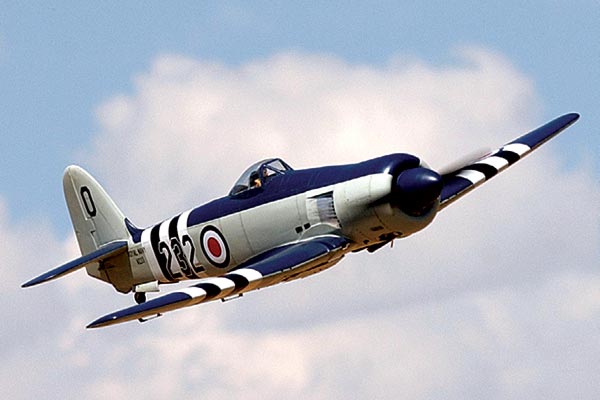
A local pilot’s Hawker Sea Fury really spiced up the noon air show, and it included realistic warbird sounds.
If you have hobby vendors at your event, plan for their location in advance as well, so that they are near the pilots but not blocking the spectators. We have also learned to control the location of pilots’ tents/shade structures, to keep the audience’s sight lines as clear as possible in the vicinity of the stands. A good parking crew is critical to keeping things flowing well. This is one of the most important but undervalued jobs at the event. The parking team is the first club contact the spectators have at the event, and first impressions are extremely important. It can be a hot, dry, and dusty shift for the club volunteers. The parking team members hand all spectator cars our full-color event brochure, ask for the donation, and tell them about the raffle. The parking officials direct visitors where to park; they keep spectator vehicles in a separate area and allow only pilot vehicles close to the pits. There are many cars to handle, and it is helpful to rope off parking lanes to keep chaos out of the parking area. One of the most important items in field preparation is bringing in and positioning mobile restroom facilities; close to 2,000 spectators and 200-300 pilots, crew, and staff down a good quantity of coffee, soda, water, hot dogs, and burgers each day. We learned that with our crowds, we must contract for our portable restrooms to be serviced on Friday and Saturday. Our wives designate some for women’s use only and decorate them with flowers and such. They stay much cleaner than the boys’ facilities. Consider prevailing wind direction and campers’ locations when positioning the temporary restroom facilities. Another important factor when the public is involved is garbage containers and collection. We have learned to provide several trash containers for the event and bring in an industrial-sized trash dumpster to help us keep on top of the situation; the 3,000 spectators create a remarkable amount of trash in just two days. Providing for cigarette-butt disposal is a fire-prevention must. They rarely end up in the designated containers, but it is important that they not go into the regular trash. We clean up the cigarettes and garbage Friday night and Saturday night, and we do a final cleanup Sunday after the event.
Registration
We post a pilot sign-up form on our club Web site and include one in the event brochure to facilitate advance registration. Model inspections and check-in start Friday afternoon, to help get ahead of the Saturday morning rush. We encourage advanced registration with a reduced event/landing fee for those who sign up early. There are typically 100-110 pilots, and having at least one-third of them preregistered has made the process more streamlined on Friday afternoon and Saturday morning. We provide the fliers with name badges and pit-crew badges. Cheerful volunteers for registration and keeping the check-in table close to the transmitter impound keeps things running smoothly.Event Program/Agenda
Balancing the pilots’ desires for an enjoyable event and the public’s desires for a great air show has been a key facet of the Rocky Mountain Big Bird Festival’s maturation. This balance is shown in the program choices we make for the event. We decided to include a world-class flier as our featured air-show demonstration pilot each year. We pay a reasonable fee to bring these special pilots in and pay their travel expenses (gas or flight costs and hotel/meal expenses).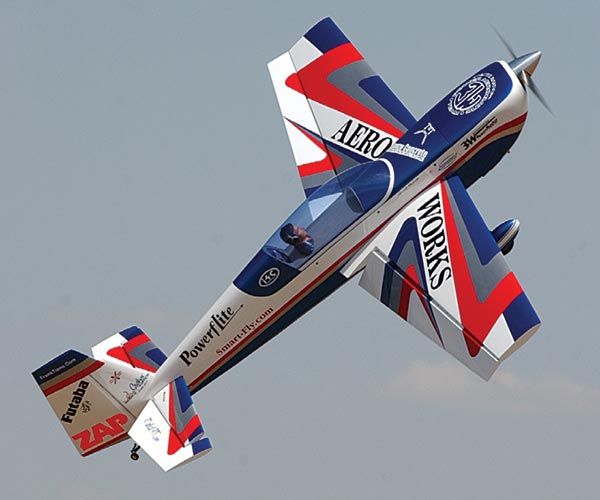
Garrett Morrison’s 3-D model in the rolling-harrier portion of his crowd-pleasing Freestyle routine.
We recoup this money by having additional spectators and pilots attend and selling incremental raffle tickets to the public at the event. Including the words “World Champ” and “National Champ” in the marketing materials seems to work well in attracting crowds and pilots. Use any relationships that any of your members have with top-shelf pilots to make the invitation process smoother. If you don’t have connections, attending events at which good, potential air-show pilots perform is a great way to introduce yourself and see how different pilots would fit into your event. We have learned a great deal through the years about the event’s structure and flow of flying and activities, such as to set specific times for 3-D flying, warbirds, and a mix of normal/sport flying and crowd buddy-box flight instruction.
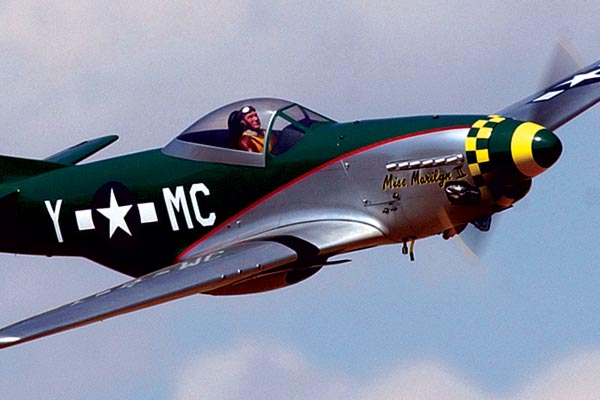
Providing designated warbird flight times brings out the showmanship from the Scale pilots. Most spectators will respond to this type of aircraft.
We found that those who spend many hours on their warbirds like to fly together and are displeased when other pilots pull 3-D Harriers directly in front of their models. So the warbird times become their own mini air shows and allow the announcers to speak about the pilots, their models, and the full-scale aircraft and their histories to keep the spectators engaged. In a like manner, the set 3-D flying times attract IMAC (International Miniature Aerobatic Club) and Freestyle enthusiasts who kick in the smoke systems, try formation aerobatics, and Torque Roll their models for the crowds.
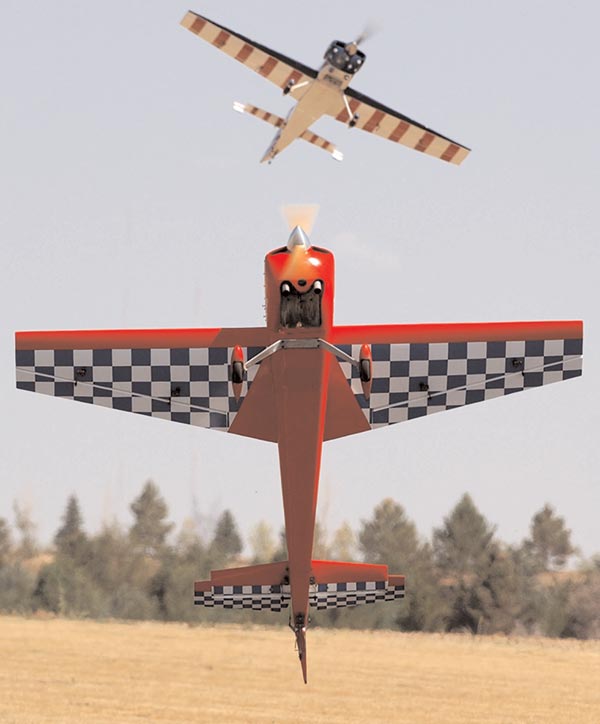
Separate 3-D flying times showcase IMAC and hotdog pilots’ flying skills in a more controlled environment.
Our featured air-show pilot is usually asked to evaluate other pilots’ aircraft, and the 3-D segment is a good time for these test flights and for the air-show pilot to check out his model before the noon demonstration. Even with a set time for 3-D flying, we mandate that Harriers and hovering maneuvers be executed out from the runway in the middle of the rectangular traffic pattern, keeping the runway mostly clear in case someone needs to land quickly for any reason. During regular flying times, we prohibit 3-D maneuvers, and the regular sport fliers come to the flightline. We encourage normal aerobatics, and the Cubs, World War I aircraft, and sport models mix it up to the crowd’s delight.

Sport-flying times at the festival included more traditional aerobatics. Biplanes are a spectator favorite.
We try to keep the six pilot stations filled at all times, but there is a natural ebb and flow of pilot volume during the day. At slower times we encourage volunteers from the crowd to fly a Giant Scale model via a buddy box and instructor. The audience loves to see other crowd members fly a model then be interviewed by the announcers. During these instruction times each day, we hold free public raffles for 40-size trainer kits/ARFs. We ask the crowd members to raise their hands if they would truly be interested in getting into the hobby, and then only those people receive tickets. Local hobby shops that help sponsor the event donate the kits. We distribute the raffle tickets and call the winner out of the stands. The proud new kit owner has his or her picture taken with the hobby-store representative, takes a turn with the buddy box/instructor, and then is interviewed for the crowd. It is fun for the audience, and there is no lack of volunteers to take a turn flying a model. We sell a good deal of raffle tickets for the Kadet during these times since the crowd can see firsthand that nearly anyone can fly with good instruction. We sell even more tickets at instruction time since our buddy-box instruction airplanes are copies of the Quinn Kadet that we raffle off, and crowd members can see how excellent a well-set-up Giant Scale model would be as a first airplane. Free hourly pilot-prize drawings, major pilot-prize raffles, and excellent pilot-prize quality help keep participants returning year after year. Our super salesperson obtains these prizes. Since the public is invited and comes for the noon air show, the pilots who attend are those who enjoy showing off their aircraft in a noncompetitive but well-managed environment. They come to enjoy the air-show demonstration featuring a world-class pilot as much as the spectators. Also allowing some regional pilots with special airplanes and skills to participate in the noon air show boosts their pride in participation.
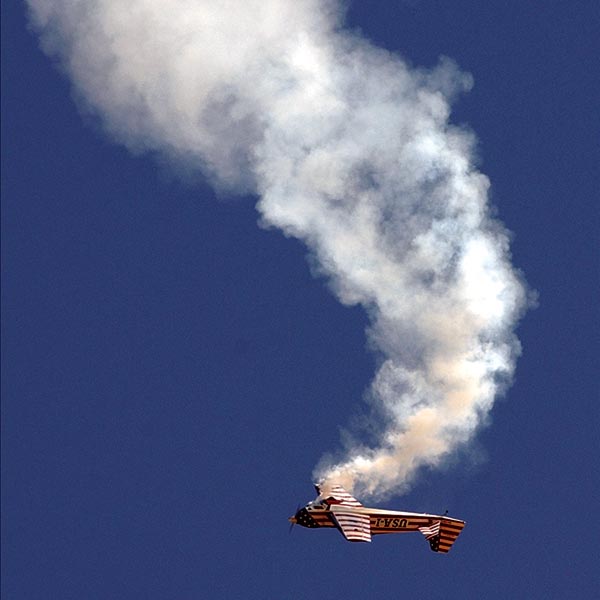
The Love Air R/C club’s best pilots also got to participate in the air show program. Smoke is a crowd pleaser!
Our Sunday air show last year featured a comedy skit featuring a 12-foot-wingspan Cub, a Giant Scale-legal turbine jet, a 50-pound Hawker Sea Fury, a 3-D and a turbine helicopter, local pilots doing 3-D aerobatics, and the finale: Garrett Morrison’s (Lodi CA) amazing Freestyle Aerobatics demonstration. During the event, the announcers are constantly broadcasting over the PA system the aircraft each pilot is flying; where the pilot is from; and the engine, kit type, and special features of the model and its full-scale counterpart. This keeps the crowd informed and involved, and it appeals to each pilot’s pride in his or her aircraft. Humor in announcing is a big asset in handling mishaps and keeping the enthusiasm level up on the flightline. We use 70-volt horn speakers on poles down the flightline in addition to the main PA system cabinets to ensure proper sound coverage for the crowd and the pilots. We announce the pilot prizes and landings, ask for applause for good flights, and help the impound crew by calling for delinquent frequency pins and announcing when pilots in the queue can fly after their frequencies clear up. To help encourage visiting pilots to get early stick time at the event, we often ask club members to refrain from flying Saturday morning to let the visitors have the first crack at it that day. Normal club flying starts each day at the end of the formal event hours, and we close the impound and distribute the radios to their owners until the next morning. We run the event impound and frequency control during event hours: 9 a.m.-4 p.m. Saturday and 9 a.m.-2 p.m. Sunday, when the Kadet is raffled off.
Social Activities
Pilots who attend the event, some every year, enjoy the social aspect and bring their RVs for dry camping starting the Tuesday and Wednesday before the event, to ensure a good spot.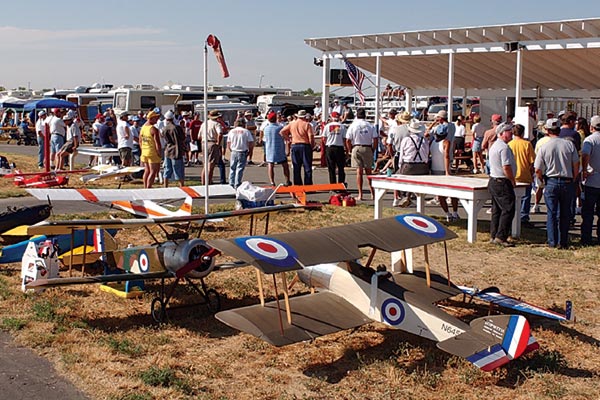
A pilots’ meeting is held at the start of every flying day, during which rules, safety, and the day’s program are reviewed.
We hold a potluck dinner Friday evening and a pig-roast dinner Saturday evening during the event. One of our member families handles the potluck dinner, and another family runs the pig roast. We have tried Saturday-evening catered dinners throughout the years, but that has presented mixed success and increased costs. The less-formal potluck and pig roast dinners have become fun traditions and are followed by a round of night flying starting at dusk Friday and Saturday evening. All manner of contraptions show up in the sky, and people either watch the craft or simply visit with friends down the line of campers and RVs.
Event Promotion
Properly marketing the fly-in has made a big difference in continuing to attract participants and increasing the number of spectators. Our first year with real marketing was coincident with having Quique Somenzini as our air-show pilot, and we went from 300 spectators the previous year to 2,500 spectators that year. Our marketing efforts are multifaceted and consist of our Web site; more than 3,000 fullcolor, two-sided, 11 x 17-inch brochures; two “Contest Calendar” ads in MA that run for several months; a 1⁄4-page black-and-white ad in MA; small ads in each of the local newspapers; and feature articles in each local paper in northern Colorado (three newspapers in three cities). We place ads in local newspapers the Friday and Saturday right before and at the start of the festival, and they reinforce the photo articles that each newspaper publishes promoting the event. We put a great deal of effort into trying to get the papers to come out and publicize the fly-in beforehand, and our objective is to have articles running on Friday or Saturday morning along with our ads.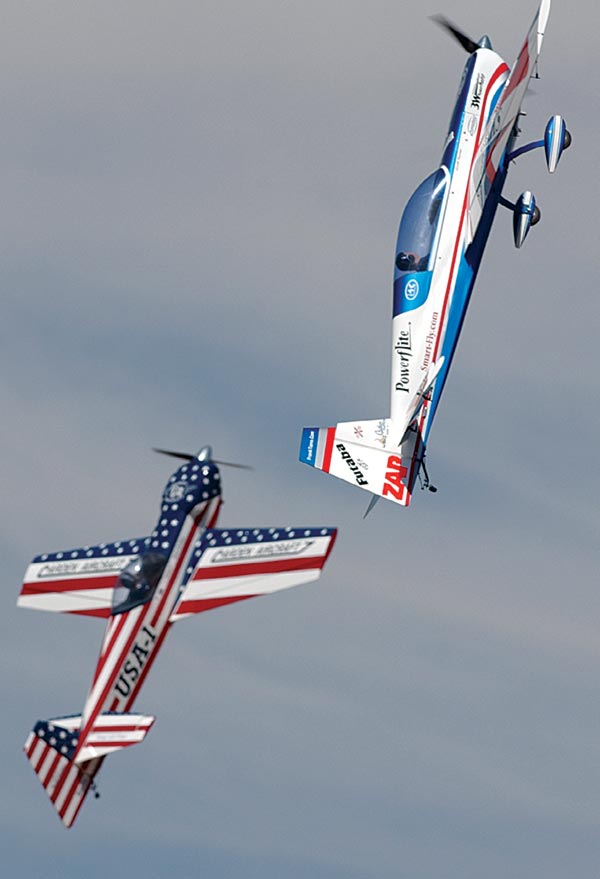
Things got interesting when the best 3-D pilots tried to outmaneuver each other. Careful co-pilot spotting is a must!
Our event brochure has evolved through the years. We now use one large, two-sided, color leaflet. The front side has large pictures and much of the spectator information. The reverse side has pilot information, a preregistration form, a map, an event schedule, and detailed directions. These handouts feature a good-size picture of the previous year’s raffle model and enough photos to show the size and variety of aircraft that will be present. We promote our guest airshow pilot and direct people to our Web site for additional information. We are only able to have a brochure of this quality because a generous club member owns a printing business. A member lays out the ads and the pamphlets, and our printer creates and donates the brochures in awesome color and quantity. This allows our members to distribute them at regional contests and use the photos to help sell raffle tickets. We distribute the leaflets to clubs and hobby stores across the state and to our mailing list of past attendees. The brochure is big enough to use as a window poster at the hobby stores. Since it has complete spectator and pilot information, the one brochure works for friends and modelers. In previous years we tried separate pilot and spectator brochures, and you always had the wrong one in your car or field box when someone asked about the event. It also doubled the cost and work for the printer. We also use the brochure at our mall show later in the year, to show the public what our main fly-in is like (we use stickers to correct the dates for the next year). See what printing connections you have within your club, and use them to the max. Last year we made a connection with an excellent professional sports photographer— Bill Sallaz of ActionPic9.com—who shot some amazing photos of Saturday’s activities. His pictures accompany this article. Bill will be at our future events, and we will be using his photography in our marketing efforts this year. Having top-quality photographs available for purchase will be another drawing card to encourage pilots to attend our event with their airplanes this year. Good photography can increase the results of your club’s marketing efforts and Web-site work.
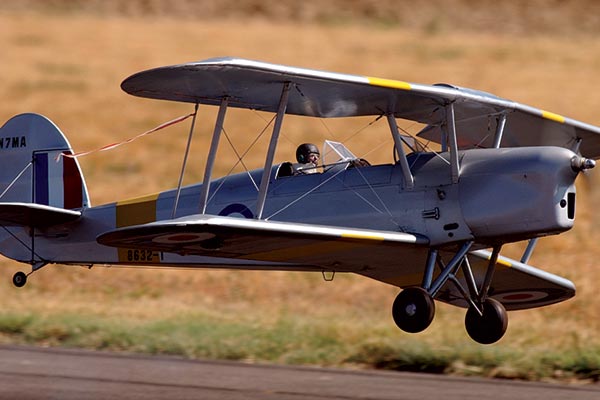
A wide variety of aircraft types, such as this Scale biplane, help attract and hold the spectators’ interest.
Television coverage is possible but hard to obtain without a good contact at the station. We did get a news crew out one year, and they did a super spot for us, but we have been unable to get them to come out again because of our distance from Denver. Any connections your members have with photographers, the press, or TV stations are valuable and should be shamelessly exploited. Anything is possible for your event. Our team has been amazed at the type of fly-in the Rocky Mountain Big Bird Festival has become. The last time Chip Hyde was our featured pilot, he said, “Man, you guys just have fun at this thing!” Our goals mix financial, promotional, and membership aspects. For more information or to contact our club, use our Web site. You can use your event for anything you want to accomplish. Your team can merge the members’ strengths and create an exciting event that shows your club and the hobby in the best light. Full-scale air shows are being increasingly controlled by spectator liability issues and are moving the crowds farther and farther from the action. You can get people closer to great looking aircraft and really get them excited about model aviation. Our hobby and your next big event can provide a unique opportunity to engage the public, attract members, and help finance your club’s operations. Set your goals, pick your team, and make it happen. -Neil Miles










Add new comment